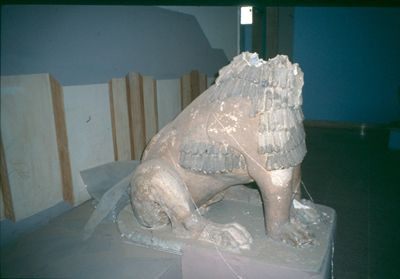After Iraq Conflict, Thieves Looted Sites To Cash In On Global Black Market

Authorities now know that ISIS is partially funded by pillaging ancient artifacts from Iraq and Syria to sell on the black market, but they’re far from the first paramilitary group to profit by destroying their own cultural heritage.
Modern-day Iraq sits on top of the ruins of ancient Mesopotamia. The region is known as the “Cradle of Civilization” for being the birthplace of organized religion, science, agriculture and the written word itself. Settlements have been recorded as far back as 3500 B.C.
Today, experts estimate the country is home to anywhere between 20,000 and 100,000 sites from ancient times.
Though most archaeological sites were spared during the U.S.-led invasion in 2003, many ancient locations that were once protected were left open to neglect and looters. That year, the National Geographic Society sent a team of archaeologists to survey the situation.
“Far more material than what has been reported missing from the Iraq Museum in Baghdad is being ripped from the ground and leaving the country,” expedition leader Henry Wright told journalists at the time. “Extraordinary damage is being wreaked on this irreplaceable archaeological record.”
Nimrud
In this former capital of the ancient Assyrian Empire, archaeologists discovered a few major royal burial sites in the late 1980s. By 2003, the gold-filled royal tombs showed major signs of stress.
The National Geographic team noted that slabs had been taken from the walls of one of the palaces. An iconic ivory relief known as the Lion of Nimrud, thought to be carved in 850 B.C., also went missing.
Guards and thieves exchanged gunfire at one point, when the looters tried to cut around a giant relief.
Nineveh
This was the most important city in ancient Assyria, and at one time a center of worship for the goddess Ishtar, that dates back between 6000 and 3000 B.C.
But the National Geographic team saw that one relief in the palace looked like “it had been attacked by sledge-hammers” and there were two massive holes right through the floor, probably by thieves looking for ivory or gold. Luckily, looters failed to get into the locked doors of the Nergal gate museum.
Dahaileh
A remote desert site, once part of lower Mesopotamia. The researchers found it in a sorry state.
“Several huge holes had been dug in the ground, probably by thieves seeking such valuables as bronze tools and jewelry from graves,” said Wright at the time.
“Ancient pots discarded by looters still lay in disarray on the ground.
Larsa
French archaeologists had excavated this large city, which was one a capital of Sumer, but today known as Senkereh, in the 1980s. But when the National Geographic team visited in 2003, they saw that looters had gone through some of the brick buildings, looking for cuneiform tablets and texts inside.
They also reported that shell casings littered the ground.
Babylon
Just over 50 miles away from Baghdad, not much remains of the city that was as the fabled capital of Babylonia for more than a thousand years. It had recently been reconstructed using plans from centuries ago, and became a popular tourist destination.
Though the museum gift shop, library and other parts were looted and partially burned during the conflict, other damage was minimal. The team wrote that a guard had fended off would-be looters with a sickle.
© Copyright IBTimes 2024. All rights reserved.





















